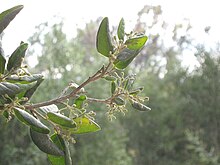Boldo
| Boldo | ||||||||||||
|---|---|---|---|---|---|---|---|---|---|---|---|---|

Peumus boldus , illustration |
||||||||||||
| Systematics | ||||||||||||
|
||||||||||||
| Scientific name | ||||||||||||
| Peumus boldus | ||||||||||||
| Molina |
The Boldo ( Peumus boldus ) is a species of plant in the Monimia family (Monimiaceae).
description
Vegetative characteristics
Peumus boldus is an evergreen shrub or small tree that reaches heights of up to 6–10 meters or more. The cracked and scaly bark is grayish to brownish.
The simple, thick leaves are whole, leathery and brittle. They are opposite and short-stalked as well as ovate or lanceolate to elliptical or obovate and blunt to marginalized or rounded to rounded at the tip. The leaves, which are lighter on the underside, are up to 5.5–7 inches long and up to 3.5–5 inches wide and are often slightly rolled up or folded in. On the warty-dotted upper side, tufted, short hairs appear at the individual points and the leaves are minimally short-haired above and below. The aromatic leaves have oil cells. Stipules are missing.
Generative characteristics
Peumus boldus is dioecious gendered dioecious . The unisexual flowers are arranged in terminal or axillary and racemose inflorescences . The very fragrant and stalked, small flowers are white to yellowish. The about 10-12 or more-piece bloom covering is arranged in circles 2-3 and is located in a cup-shaped inside and outside hairy flower soil . The outer tepals are sepaloid, green and hairy, the inner petaloid. The male flowers have many stamens in several circles in the flower base , with two small, lateral appendages ( nectar glands ) on the more or less long, basal hairy stamens. Are with the female flowers haired, almost sedentary, 3-5 individual (apokarpe) and approximate, under constant stamps , each with a short style with elongated scar and some basal hairy staminodes present.
The egg-shaped, slightly hairy to bald, smooth, mostly solitary stone fruits are yellowish-green. They rarely appear individually or up to 5 on the plate-shaped remainder of the flower base and they are about 2 centimeters tall. The veiny-structured, light brownish stone cores are round to ovoid and about 5–6 millimeters in size.
The number of chromosomes is 2n = 78.
Systematics
It was first described in 1782 by Juan Ignacio Molina in Saggio sulla storia naturale del Chili: 185, 350.Synonyms are Boldu chilanum Nees , Laurus belloto Miers ex Nees , Laurus lingui Bridges ex Nees , Ruizia fragrans Ruiz & Pav. , Boldea boldus (Molina) Looser and Boldea fragrans (pers.) Endl.
distribution
Peumus boldus is adapted to dry climates . It is originally from Chile , but occurs to Peru . However, this species also occurs in the wild in the Mediterranean region, especially in North Africa .
use
The sweet and aromatic fruits are used raw and cooked.
The wood is little used.
Boldo leaves are used in Peruvian, Argentine, Brazilian and Chilean folk medicine as a medicinal plant, among other things against gastrointestinal complaints. The plant has an antispasmodic effect and stimulates the secretion of bile in the liver cells. Boldo leaves can also be used as a spice or tea, e.g. B. in mate tea . They contain, among other things, alkaloids (especially boldine ), 1,8-cineole and ascaridol . An essential oil can also be extracted from the leaves. The dried and powdered leaves are used to perfume and protect clothing from insects.
The bark and leaves are also used as a spice. The rind contains tannins and is also used for coloring.
The dried fruits are also made into ribbons or necklaces, they then give off a pleasant smell of cinnamon.
Individual evidence
- ↑ Peumus boldus at Chileflora (under More Photos).
- ^ Peumus boldus at Tropicos.org. In: IPCN Chromosome Reports . Missouri Botanical Garden, St. Louis.
- ↑ archive.org
- ↑ Entry on Boldo. In: Römpp Online . Georg Thieme Verlag, accessed on June 15, 2014.
literature
- The great encyclopedia of medicinal plants and drugs. AREA, 2001, 2007, ISBN 3-89996-508-6 .
- K. Kubitzki , JG Rohwer , V. Bittrich: The Families and Genera of Vascular Plants. Vol. II: Flowering Plants Dicotyledons , Springer, 1993, ISBN 978-3-642-08141-5 (Reprint), pp. 426-437.
- SD Palma, G. Barboza, JM Llabot, MC Luján: Design of Peumus boldus tablets by direct compression using a novel dry plant extract. In: International Journal of Pharmaceutics. 233 (1-2), 2002, 191-8, doi: 10.1016 / S0378-5173 (01) 00940-1 , online at researchgate.net.
- PN Ravindran: The Encyclopedia of Herbs and Spices. CABI, 2017, ISBN 978-1-78064-315-1 (2 volume set), p. 136 f.
- A. Engler, E. Gilg, J. Perkins: The vegetable kingdom. IV, 101: Monimiaceae , Engelmann, 1901, p. 16 f, online at biodiversitylibrary.org.
Web links
- Peumus boldus at Useful Tropical Plants.
- Information from Katzer.
- Boldo at Medicinal Plants Catalog.
- Boldo at Raintree, The Tropical Plant Database.
- Peumus boldus at Dr Duke's Phytochemical Databases.
- Boldostrauch at medicinal plant lexicon of the Phytopharmaka cooperation.


